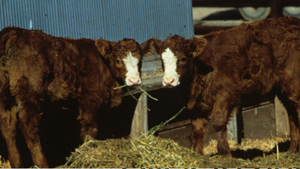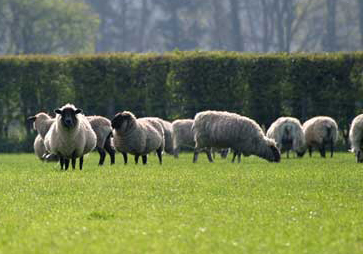We’re Gonna Need a Bigger Lab: Large Animal Models in Research
by
 The main large animal models used for biomedical research are domesticated livestock species, such as cows, sheep, goats, pigs, and occasionally horses. This section will not cover primate models, or companion animals such as dogs and cats, which although are “large animals” have their unique set of attributes and issues as animal models. Large animal models are not as widely used as mice, flies, or nematodes. One reason for this is the obvious need for space to maintain these animals.
The main large animal models used for biomedical research are domesticated livestock species, such as cows, sheep, goats, pigs, and occasionally horses. This section will not cover primate models, or companion animals such as dogs and cats, which although are “large animals” have their unique set of attributes and issues as animal models. Large animal models are not as widely used as mice, flies, or nematodes. One reason for this is the obvious need for space to maintain these animals.
Frequently, large animal models are found at universities that have animal science departments, or schools of veterinary medicine. There are medical schools and other departments that use large animal models as well though, particularly sheep. Obtaining funding for research using large animal models may also be more difficult, and researchers that have experience using these models is diminishing. This has been cause for some concern in recent years (1, 2). Besides NIH funding for research, the United States Department of Agriculture (USDA) provides some funding as well; however the portion of the USDA budget that is allocated to research grants is much smaller than that of the NIH budget (1).
Historically, large animals have made many contributions to greater understanding of human health:
- The first smallpox vaccine was generated using the cowpox virus (3).
- Studies on freemartin cattle (females born twin to a male) and allograft tolerance between twins was the basis for the Nobel Prize in 1960 (4)
- Sperm cells were first frozen in cattle before this technology was applied to humans (5, 6).
- Since 1960, hundreds of thousands of pig and cow heart valves have been placed in humans.
- The first cloned mammal from a non-reproductive cell was a sheep (7)
- Pig and sheep hypothalami were used to isolate and sequence thyroid stimulating hormone (TSH) and gonadotropin releasing hormone (GnRH), leading to the Nobel Prize 1977 (8)
- Prostaglandins were first isolated from sheep, leading to the Nobel Prize 1982 (9)
- Cow and pigs were used as a source for insulin from the 1920’s to the 1980’s.
- Prions first isolated from sheep and goats, leading to the Nobel Prize 1997 (10)
 What is unique to using large animal models?
What is unique to using large animal models?
Size does matter. Large animal research opens up the possibility to take frequent biopsies and samples, obtain many more cells from one sample, as well as catheterize multiple vessels that cannot be done in small animals such as rodents. One example is the ability to catheterize both the maternal and fetal vasculature during pregnancy. This allows researchers to obtain multiple samples throughout gestation under different experimental conditions in order to study transfer across the placenta (11). Another is the ability to non-invasively monitor ovarian development by ultrasound, and take samples from ovarian follicles after different treatments, without having to sacrifice the animal. The similarity in organ size in some animal models allows for better models of surgery, hemodynamics, and possible future xenotransplantation. While hundreds of thousands of people have benefited from pig and cow heart valves already, the recent development of a α-1,3-galactosyltransferase “knockout” pig (12) may allow transplantation of whole organs without rejection by the immune system. Large animals can be used for “pharming” to produce large quantities of useful proteins in milk of transgenic cows, pigs, sheep, or goats, such as a1-antitrypsin produced in sheep for patients with pulmonary emphysema that lack this enzyme (13). Besides these general examples, each species has particular attributes which may make it a good candidate for certain types of research. Below are just some examples, although there are many more..
Sheep: Studying osteoporosis and evaluation of orthopedic implants due to large size of bones and similar response to estrogen replacement therapy in aged, ovariectomized ewes (14).
Cows: Availability of slaughterhouse-derived ovaries allows use of 1000’s of oocytes for in vitro embryo culture studies.
Pigs: Similarity in GI tract anatomy and physiology makes them good models for human nutrition. Pigs also have a tendency to overeat and develop obesity, arthrosclerosis (15).
Horses: Very long lifespan, and similar patterns of ovarian follicle development may make this animal useful for studies into fertility in aging women (16)
Finally, a unique advantage to using livestock or companion animal species is that it also allows for “dual-purpose” research (17). That is research that not only benefits human health by greater understanding of biological processes, but can also advance animal agriculture so that we have a continued supply of abundant, safe, affordable, and high quality meat and dairy products.
What are the weaknesses of using large animal models?
 In general, there is a lack of antibodies and other reagents available for many large animal models compared to rodents. More are becoming available, particularly for sheep. Recently, their genomes have been sequenced, or are in the process of being sequenced, which will further advance research. Larger animal models are not inbred, so there is more genetic variation and “noise” in an experiment. Also from a genetic standpoint, the ability to manipulate gene function in rodent models is easier than in most domestic species. However, comparing conserved sequences and identifying conserved gene function across a variety of mammalian species may be beneficial in extrapolation of this information to function in humans.
In general, there is a lack of antibodies and other reagents available for many large animal models compared to rodents. More are becoming available, particularly for sheep. Recently, their genomes have been sequenced, or are in the process of being sequenced, which will further advance research. Larger animal models are not inbred, so there is more genetic variation and “noise” in an experiment. Also from a genetic standpoint, the ability to manipulate gene function in rodent models is easier than in most domestic species. However, comparing conserved sequences and identifying conserved gene function across a variety of mammalian species may be beneficial in extrapolation of this information to function in humans.
Housing facilities for large animals may also be an issue at some institutions, and costs per animal are usually greater than in rodents. These are variable, but prices are in the hundreds of dollars per animal, about ten times that of mice. Per diem rates also vary and can depend on weather and hay costs, but for sheep can range from $6-7/day and for horses up to $10-14/day. It is good to keep in mind that in some cases multiple samples can be taken from the same animal without sacrifice, and a greater amount of sample material may be obtained, which could allow research to be conduced with fewer numbers of animals than using rodents. Particularly in the case of horses, animal costs can be significant and having an adequate number of animals can be problem for some projects. Animal care and use protocols and regulations are similar to those for odent models. Lastly, large animals have significantly longer generation intervals, which can be problematic for some projects.
_____________________________________________________
Scott completed his B.S. and M.S. in the Animal Sciences Department at Virginia Tech followed by a Ph.D. in Biomedical Sciences in the College of Veterinary Medicine at Colorado State University. He has published research using cattle, pigs, horses, and sheep animal models. He is currently down-sizing to mouse models while doing postdoctoral research in the Ob/Gyn Department at Washington University in St. Louis.
__________________________________________________________
References:
1. Roberts, R.M., et al. 2009. Farm Animal Research in Crisis. Science. 324: 468-469.
2. Reynolds, L.P., Ireland, J.J., and Seidel, G.E. 2008. Editorial: “Brain drain” and loss of resources jeopardize the continued use of domestic animals for agricultural and biomedical research. J. Anim. Sci. 86: 2445-2446.
3. Barquet, N., Domingo, P. 1997. Smallpox: The triumph over the most terrible of the ministers of death. Ann. Int. Med. 127: 635-642.
4. Anderson, D., Billingham, R.E., Lamkin, G.H., Medawar, P.B. 1951. Use of skin grafting to distinguish between monozygotic and dizygotic twins in cattle. Heredity. 5:379.
5. Polge, C., Smith, A.U., Parkes, A.S. 1949. Revival of spermatozoa after vitrification and dehydration at low temperatures. Nature 164:666.
6. Foote, R.H. 1982. Cryopreservation of spermatozoa and artificial insemination: past, present, and future. J. Androl. 3: 85-100.
7. Campbell, K.H.S., McWhir, J., Ritchie, W.A., Wilmut, I. 1996. Sheep cloned by nuclear transfer from a cultured cell line. Nature 380: 64-66.
8. Schally, A.V. Nobel Lecture-Aspects of hypothalamic regulation of the pituitary gland with major emphasis on its implications for the control of reproductive processes. 1977. [www.nobel/se/medicine/laureates/1977/schally-lecture.html]
9. Flower, R.J. 2006. Prostaglandins, bioassay and inflammation. Brit. J. Pharm. 147: 182-192.
10. Prusiner, S.B. 1982. Novel proteinaceous infectious particles cause scrapie. Science 216:136-144.
11. Barry, J.S., Rozance, P.J., Anthony, R.V. 2008. An animal model of placental insufficiency induced intrauterine growth restriction. Semin. Perinatal. 32: 225-230.
12. Tseng, Y-L., et al. 2005. Alpha 1,3-galactosyltransferase gene knockout pig heart transplantation in baboons with survival approaching six months. Xenotransplantation 80: 1493-1500.
13. Das, R.C. 2001. Production of therapeutic proteins from transgenic animals. BioBusiness 60:64.
14. Turner, A.S. 2001. Animal models of osteoporosis-necessity and limitations. Eur. Cells Mat. 1:66-81.
15. Bergen, W.G., Mersmann, H.J. 2005. Comparative aspects of lipid metabolism: Impact on contemporary research and use of animal models. J. Nutri. 135: 2499-2502.
16. Carnevale, E.M. 2008. The mare model for follicular maturation and reproductive aging in the woman. Theriogenology. 69: 23-30.
17. Ireland, J.J., et al. 2008. A commentary on domestic animals as dual-purpose models that benefit agricultural and biomedical research. J. Anim. Sci. 86: 2797-2805.
Resources and further reading:
Advantages of domestic species as dual purpose models that benefit agricultural and biomedical research: http://adsbm.msu.edu/
Foundation for Biomedical Research http://www.fbresearch.org/
National Association for Biomedical Research http://www.nabr.org/
_________________________________________________________
See other articles in the series:
Drosophila melanogaster- The fruit fly.
Research’s Next Top Model (Zebrafish)
Getting to Know Your Worms (C. elegans)
Saccharomyces cerevisiae a.k.a Budding/Baker’s/Brewer’s Yeast
The Almighty Fungi: The Revolutionary Neurospora crassa
Tetrahymena: Little Creature, Big Discoveries
.


lbeben
wrote on August 3, 2011 at 9:54 pm
I am a decidedly biased advocate of large animal testing. I understand the preference for bovine prostheses, yet firmly believe the porcine aortic valve is as close in nature as one can match to a human bioprosthetic intervention.